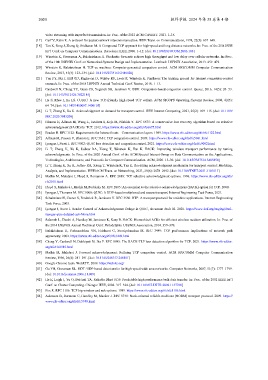Page 442 - 《软件学报》2024年第4期
P. 442
2020 软件学报 2024 年第 35 卷第 4 期
video streaming with imperfect transmission. In: Proc. of the 2021 ACM CoNEXT. 2021. 1–16.
[17] Cerf V, Kahn R. A protocol for packet network intercommunication. IEEE Trans. on Communications, 1974, 22(5): 637–648.
[18] Tan K, Song J, Zhang Q, Sridharan M. A Compound TCP approach for high-speed and long distance networks. In: Proc. of the 25th IEEE
Int’l Conf. on Computer Communications. Barcelona: IEEE, 2006. 1–12. [doi: 10.1109/INFOCOM.2006.188]
[19] Winstein K, Sivaraman A, Balakrishnan H. Stochastic forecasts achieve high throughput and low delay over cellular networks. In: Proc.
of the 10th USENIX Conf. on Networked Systems Design and Implementation. Lombard: USENIX Association, 2013. 459–472.
[20] Winstein K, Balakrishnan H. TCP ex machina: Computer-generated congestion control. ACM SIGCOMM Computer Communication
Review, 2013, 43(4): 123–134. [doi: 10.1145/2534169.2486020]
[21] Yan FY, Ma J, Hill GD, Raghavan D, Wahby RS, Levis P, Winstein K. Pantheon: The training ground for Internet congestion-control
research. In: Proc. of the 2018 USENIX Annual Technical Conf. Boston, 2018. 1–13.
[22] Cardwell N, Cheng YC, Gunn CS, Yeganeh SH, Jacobson V. BBR: Congestion-based congestion control. Queue, 2016, 14(5): 20–53.
[doi: 10.1145/3012426.3022184]
[23] Ha S, Rhee I, Xu LS. CUBIC: A new TCP-friendly high-speed TCP variant. ACM SIGOPS Operating Systems Review, 2008, 42(5):
64–74. [doi: 10.1145/1400097.1400105]
[24] Li T, Zheng K, Xu K. Acknowledgment on demand for transport control. IEEE Internet Computing, 2021, 25(2): 109–115. [doi: 10.1109/
MIC.2020.3045208]
[25] Blanton E, Allman M, Wang L, Jarvinen I, Kojo M, Nishida Y. RFC 6675: A conservative loss recovery algorithm based on selective
acknowledgment (SACK) for TCP. 2012. https://www.rfc-editor.org/rfc/rfc6675.html
[26] Braden R. RFC 1122: Requirements for Internet hosts—Communication layers. 1989. https://www.rfc-editor.org/rfc/rfc1122.html
[27] Allman M, Paxson V, Blanton E. RFC 5681: TCP congestion control. 2009. https://www.rfc-editor.org/rfc/rfc5681.html
[28] Iyengar J, Swett I. RFC 9002: QUIC loss detection and congestion control. 2021. https://www.rfc-editor.org/rfc/rfc9002.html
[29] Li T, Zheng K, Xu K, Jadhav RA, Xiong T, Winstein K, Tan K. TACK: Improving wireless transport performance by taming
acknowledgments. In: Proc. of the 2020 Annual Conf. of the ACM Special Interest Group on Data Communication on the Applications,
Technologies, Architectures, and Protocols for Computer Communication. ACM, 2020. 15–30. [doi: 10.1145/3387514.3405850]
[30] Li T, Zheng K, Xu K, Jadhav RA, Xiong T, Winstein K, Tan K. Revisiting acknowledgment mechanism for transport control: Modeling,
Analysis, and Implementation. IEEE/ACM Trans. on Networking, 2021, 29(6): 2678–2692. [doi: 10.1109/TNET.2021.3101011]
[31] Mathis M, Mahdavi J, Floyd S, Romanow A. RFC 2018: TCP selective acknowledgment options. 1996. https://www.rfc-editor.org/rfc/
rfc2018.html
[32] Floyd S, Mahdavi J, Mathis M, Podolsky M. RFC 2883: An extension to the selective acknowledgement (SACK) option for TCP. 2000.
[33] Iyengar J, Thomson M. RFC 9000: QUIC: A UDP-based multiplexed and secure transport. Internet Engineering Task Force, 2021.
[34] Schulzrinne H, Casner S, Frederick R, Jacobson V. RFC 3550: RTP: A transport protocol for real-time applications. Internet Engineering
Task Force, 2003.
[35] Iyengar J, Swett I. Sender Control of Acknowledgement Delays in QUIC, document draft 02. 2020. https://www.ietf.org/staging/draft-
iyengar-quic-delayed-ack-None.html
[36] Salameh L, Zhushi A, Handley M, Jamieson K, Karp B. HACK: Hierarchical ACKs for efficient wireless medium utilization. In: Proc. of
the 2014 USENIX Annual Technical Conf. Philadelphia: USENIX Association, 2014. 359–370.
[37] Balakrishnan H, Padmanabhan VN, Fairhurst G, Sooriyabandara M. RFC 3449: TCP performance implications of network path
asymmetry. 2002. https://www.rfc-editor.org/rfc/rfc3449.html
[38] Cheng Y, Cardwell N, Dukkipati N, Jha P. RFC 8985: The RACK-TLP loss detection algorithm for TCP. 2021. https://www.rfc-editor.
org/rfc/rfc8985.html
[39] Mathis M, Mahdavi J. Forward acknowledgement: Refining TCP congestion control. ACM SIGCOMM Computer Communication
Review, 1996, 26(4): 281–291. [doi: 10.1145/248157.248181]
[40] Google Chrome team. WebRTC. 2019. https://webrtc.org/
[41] Gu YH, Grossman RL. UDT: UDP-based data transfer for high-speed wide area networks. Computer Networks, 2007, 51(7): 1777–1799.
[doi: 10.1016/j.comnet.2006.11.009]
[42] He E, Leigh J, Yu O, DeFanti TA. Reliable Blast UDP: Predictable high performance bulk data transfer. In: Proc. of the 2002 IEEE Int’l
Conf. on Cluster Computing. Chicago: IEEE, 2002. 317–324. [doi: 10.1109/CLUSTR.2002.1137760]
[43] Fox R. RFC 1106: TCP big window and nak options. 1989. https://www.rfc-editor.org/rfc/rfc1106.html
[44] Adamson B, Bormann C, Handley M, Macker J. RFC 5740: Nack-oriented reliable multicast (NORM) transport protocol. 2009. https://
www.rfc-editor.org/rfc/rfc5740.html

